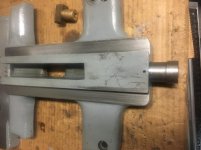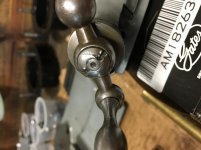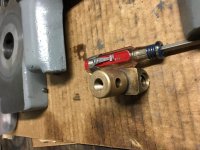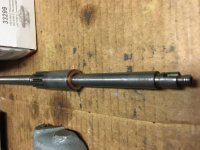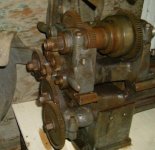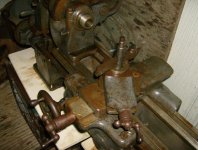Hi all,
Purchased an old South Bend 9C underdrive unit as my first lathe. The lathe is an early model with the headstock cover extending down and thru the split ways. Before using it, if figured on making sure it was in fairly good working order so I purchased Ilion Industrial Services "A guide to Renovating the South Bend Lathe" book, felts, and oil kit but it appears that many of my disassembly questions aren't covered in the book so I'm turning to the collective knowledge of this forum for help.
First, there is no 1/8" hole in the cross feed screw collar to install the pin spanner to remove it. Were these pressed in on early lathes? Not sure if I even need to remove it as I took the feed screw out the back.
Second, I'm missing the set screw and pin from the bronze feed nut. The set screw is easy to replace using a fine thread 5/16 screw but I'm not sure of were to find the pin. Alternatively does anyone know the dimensions that I could make one up? How does it work? Seems like the set screw would simple bear down on it but I'm sure it must press against the inside of the bore to lock the screw nut in place vertically, just can't picture how in my mind.
Third, I need to find a split retaining nut for the handle. Anyone willing to sell one or know where I can source it?
Finally, there seems to be excessive backlash in the cross feed screw. The screw itself looks good but the nut is chewed up pretty good and will be replaced, probably from not having the set screw and pin but I think that's only part of the problem. If I install a small washer on the screw shaft between the screw and the screw collar it takes up a lot of the slack. Is this an appropriate fix?
Purchased an old South Bend 9C underdrive unit as my first lathe. The lathe is an early model with the headstock cover extending down and thru the split ways. Before using it, if figured on making sure it was in fairly good working order so I purchased Ilion Industrial Services "A guide to Renovating the South Bend Lathe" book, felts, and oil kit but it appears that many of my disassembly questions aren't covered in the book so I'm turning to the collective knowledge of this forum for help.
First, there is no 1/8" hole in the cross feed screw collar to install the pin spanner to remove it. Were these pressed in on early lathes? Not sure if I even need to remove it as I took the feed screw out the back.
Second, I'm missing the set screw and pin from the bronze feed nut. The set screw is easy to replace using a fine thread 5/16 screw but I'm not sure of were to find the pin. Alternatively does anyone know the dimensions that I could make one up? How does it work? Seems like the set screw would simple bear down on it but I'm sure it must press against the inside of the bore to lock the screw nut in place vertically, just can't picture how in my mind.
Third, I need to find a split retaining nut for the handle. Anyone willing to sell one or know where I can source it?
Finally, there seems to be excessive backlash in the cross feed screw. The screw itself looks good but the nut is chewed up pretty good and will be replaced, probably from not having the set screw and pin but I think that's only part of the problem. If I install a small washer on the screw shaft between the screw and the screw collar it takes up a lot of the slack. Is this an appropriate fix?


